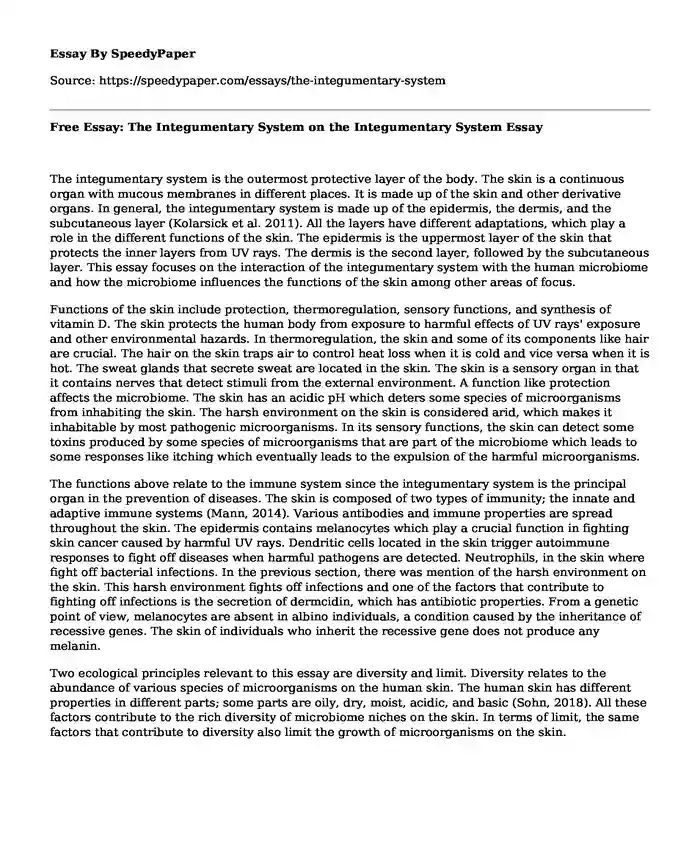The integumentary system is the outermost protective layer of the body. The skin is a continuous organ with mucous membranes in different places. It is made up of the skin and other derivative organs. In general, the integumentary system is made up of the epidermis, the dermis, and the subcutaneous layer (Kolarsick et al. 2011). All the layers have different adaptations, which play a role in the different functions of the skin. The epidermis is the uppermost layer of the skin that protects the inner layers from UV rays. The dermis is the second layer, followed by the subcutaneous layer. This essay focuses on the interaction of the integumentary system with the human microbiome and how the microbiome influences the functions of the skin among other areas of focus.
Functions of the skin include protection, thermoregulation, sensory functions, and synthesis of vitamin D. The skin protects the human body from exposure to harmful effects of UV rays' exposure and other environmental hazards. In thermoregulation, the skin and some of its components like hair are crucial. The hair on the skin traps air to control heat loss when it is cold and vice versa when it is hot. The sweat glands that secrete sweat are located in the skin. The skin is a sensory organ in that it contains nerves that detect stimuli from the external environment. A function like protection affects the microbiome. The skin has an acidic pH which deters some species of microorganisms from inhabiting the skin. The harsh environment on the skin is considered arid, which makes it inhabitable by most pathogenic microorganisms. In its sensory functions, the skin can detect some toxins produced by some species of microorganisms that are part of the microbiome which leads to some responses like itching which eventually leads to the expulsion of the harmful microorganisms.
The functions above relate to the immune system since the integumentary system is the principal organ in the prevention of diseases. The skin is composed of two types of immunity; the innate and adaptive immune systems (Mann, 2014). Various antibodies and immune properties are spread throughout the skin. The epidermis contains melanocytes which play a crucial function in fighting skin cancer caused by harmful UV rays. Dendritic cells located in the skin trigger autoimmune responses to fight off diseases when harmful pathogens are detected. Neutrophils, in the skin where fight off bacterial infections. In the previous section, there was mention of the harsh environment on the skin. This harsh environment fights off infections and one of the factors that contribute to fighting off infections is the secretion of dermcidin, which has antibiotic properties. From a genetic point of view, melanocytes are absent in albino individuals, a condition caused by the inheritance of recessive genes. The skin of individuals who inherit the recessive gene does not produce any melanin.
Two ecological principles relevant to this essay are diversity and limit. Diversity relates to the abundance of various species of microorganisms on the human skin. The human skin has different properties in different parts; some parts are oily, dry, moist, acidic, and basic (Sohn, 2018). All these factors contribute to the rich diversity of microbiome niches on the skin. In terms of limit, the same factors that contribute to diversity also limit the growth of microorganisms on the skin.
References
Mann, E. (2014). Review: Skin and the Immune System. Journal Of Clinical & Experimental Dermatology Research, 4(3). doi: 10.4172/2155-9554.s2-003
Sohn, E. (2018). Skin microbiota's community effort. Nature, 563(7732), S91-S93. doi: 10.1038/d41586-018-07432-8
Kolarsick, P., Kolarsick, M., & Goodwin, C. (2011). Anatomy and Physiology of the Skin. Journal Of The Dermatology Nurses' Association, 3(4), 203-213. doi: 10.1097/jdn.0b013e3182274a98
Cite this page
Free Essay: The Integumentary System on the Integumentary System. (2023, Feb 02). Retrieved from https://speedypaper.com/essays/the-integumentary-system
Request Removal
If you are the original author of this essay and no longer wish to have it published on the SpeedyPaper website, please click below to request its removal:
- Development Option Proposed by Libyan Government, Essay Example
- Dependent Personality Disorder Essay
- Essay Sample: The Context and Social History of the Case
- Employee Satisfaction: Finding a Balance for Maximum Performance
- Paper Example. The Good Impacts of WhatsApp
- The Difference Between Counseling and Psychotherapy. Free Essay
- Free Essay Example. Amazon Alexa and Patient Engagement
Popular categories





